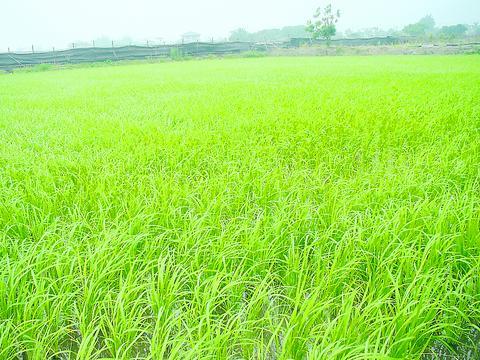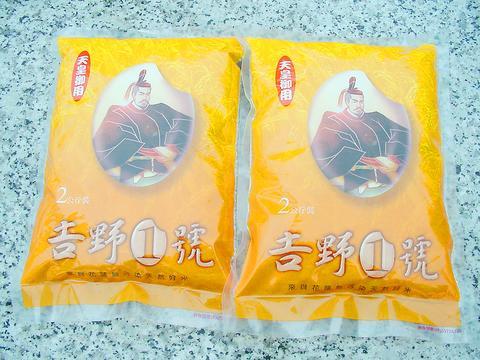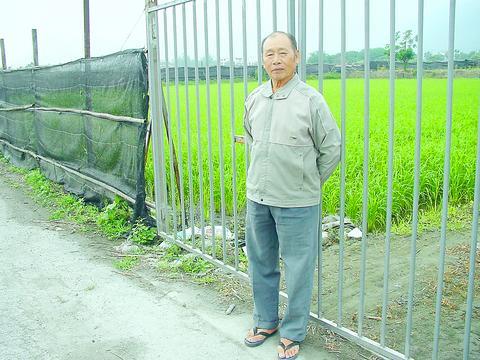"I never got to be an emperor and I never lived like one," joked Peng Yong-chuan (
The 75-year-old Hakka farmer born in Hsinchu, who settled in Hualien County, is almost single-handedly responsible for preserving Yoshino No. 1 (

Also known as "Japanese Emperor's rice" (

Yoshino No. 1, unlike other rice varieties, is said to have an appealing smell and unique taste when it's properly prepared. It has a sweet flavor that stays on the palate even after a lot of chewing. Its grains are rounder and plumper than other varieties and are crystal clear, with a white, heart-shaped dot in the middle. Japanese growers claimed the shape of the dot was similar to the sun rising on the nation's white flag and thus cherished the rice even more.
Cultivating the rice, however, is extremely labor-intensive and too much or too little wind, rain or fertilizer destroys the crop. Also, without proper care, the length of the stem easily exceeds 110cm before ears of rice develop. There is a critical point where the stem can no longer support the weight of the ears of rice and bends over. If this happens the rice changes in taste and is fit only for chicken feed. It is essential, then, that the crop is picked at the right time. Too early and the rice is not ready, too late and it's over ripe.

Birds like the rice so much, according to agriculture official Chen Ming-te (
As a result of the difficulty of growing the rice and the departure of the Japanese after World War II, production of Yoshino No. 1 stopped because the cost of growing it was higher than the returns.
It wasn't until 1969, when Peng retired from his hospital job after 20 years and started helping his in-laws cultivate a large piece of farmland, that Japanese emperor's rice would be cultivated again. Peng recalled stories told by his primary school teacher in Hualien about the quality of the rice and was inspired to try growing it himself.
He was lucky enough to obtain some seeds of the long-forgotten rice from an old colleague working in the Farming Reform Field (
Originally, Yoshino No. 1 was invented by Aoki Shigelu (青木繁氏) in 1926 and was first known as "Aoki rice" (青木米). In 1909, the Japanese government's policy of managed emigration to relieve domestic population pressures, meant that "immigration villages" were set up in Hualien. Immigrants from Tokushima Ken and Kagawan Ken in Shikoku Prefecture started to cultivate paddy rice in what used to be known as Chijiaochuang. Now known as Chian township village, it was then named after some of the immigrants' hometown of Yoshinokawa.
Among the new settlers, Shigelu was an agriculture researcher and developed a new variety of rice by crossing a Japanese rice plant Kikuchi Mai (
The year after it was developed, the new breed of rice was presented to Emperor Hirohito as a tribute and was given its official name, Yoshino No. 1. Two hectares of rice fields at the back of Taohsing Primary School, in Chian, were then designated for the exclusive production of the rice. The field was looked after by a group of agricultural researchers and specialists and was guarded closely by local township officials. One of their major duties was to scare birds away from the field.
Peng told this reporter a story which he said he had never told anyone before. He said when the rice was harvested, Japanese officials would pick a dozen or so local young Japanese girls to pick and package the rice. These young girls were required to take a bath and change into new clothes prior to performing their duties, as a token of their respect for the emperor. They would peel off the husks on the rice, by hand, one by one. No Taiwanese girls were chosen for the job, perhaps because of security concerns.
A traditional Japanese ceremony would be held to bless the rice and to plead for special blessings from the emperor. The handpicked 10kg or so of Yoshino No. 1 rice was then shipped from Hualien to its final destination -- the Emperor's Palace in Tokyo. Whatever was left over was then presented to the Japanese Colonial Governor's Palace in Taipei.
According to Kang Mu-shu (
Now, more farmers in Hualien are eager to plant the rice because demand is steadily increasing, and since it can only be produced in Chian, its selling price is much higher than other varieties. Normally, 60kg of rice sells for about NT$1,000. Yoshino No. 1 sells for nearly double that.
Without Peng's dedicated efforts Yoshino No. 1 could have vanished into history for good. Not only has Peng brought fame and trade to his hometown, he has also saved a part of Taiwan's cultural heritage.

On April 26, The Lancet published a letter from two doctors at Taichung-based China Medical University Hospital (CMUH) warning that “Taiwan’s Health Care System is on the Brink of Collapse.” The authors said that “Years of policy inaction and mismanagement of resources have led to the National Health Insurance system operating under unsustainable conditions.” The pushback was immediate. Errors in the paper were quickly identified and publicized, to discredit the authors (the hospital apologized). CNA reported that CMUH said the letter described Taiwan in 2021 as having 62 nurses per 10,000 people, when the correct number was 78 nurses per 10,000

May 5 to May 11 What started out as friction between Taiwanese students at Taichung First High School and a Japanese head cook escalated dramatically over the first two weeks of May 1927. It began on April 30 when the cook’s wife knew that lotus starch used in that night’s dinner had rat feces in it, but failed to inform staff until the meal was already prepared. The students believed that her silence was intentional, and filed a complaint. The school’s Japanese administrators sided with the cook’s family, dismissing the students as troublemakers and clamping down on their freedoms — with

As Donald Trump’s executive order in March led to the shuttering of Voice of America (VOA) — the global broadcaster whose roots date back to the fight against Nazi propaganda — he quickly attracted support from figures not used to aligning themselves with any US administration. Trump had ordered the US Agency for Global Media, the federal agency that funds VOA and other groups promoting independent journalism overseas, to be “eliminated to the maximum extent consistent with applicable law.” The decision suddenly halted programming in 49 languages to more than 425 million people. In Moscow, Margarita Simonyan, the hardline editor-in-chief of the

Six weeks before I embarked on a research mission in Kyoto, I was sitting alone at a bar counter in Melbourne. Next to me, a woman was bragging loudly to a friend: She, too, was heading to Kyoto, I quickly discerned. Except her trip was in four months. And she’d just pulled an all-nighter booking restaurant reservations. As I snooped on the conversation, I broke out in a sweat, panicking because I’d yet to secure a single table. Then I remembered: Eating well in Japan is absolutely not something to lose sleep over. It’s true that the best-known institutions book up faster